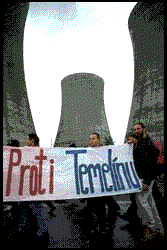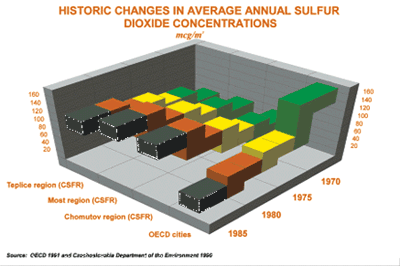
- CECHECK-up
- Fingerprinting the Culprits
- Pollution Plagues Bulgarian Center
- Insider's View
- Controversy Prompts Action in Central Europe
- Chernobyl Remembered
- Russians Suffer - Seven Years After the Accident
- WHO Tracks Health Effects
- Ukrainian Studies Highlight Thyroid Cancer, Stress
- CECHE in the News
- Media Training: The Sky's the Limit
- PVO-NIS Project Heads for Self-Sufficiency
- New PSA's Challenge Russians
- Noxious Lead in Poland
For articles to which there are no links, contact CECHE to request a free copy via e-mail at CECHE@att.net. The entire issue costs $7.5. Provide complete address, telephone number, fax, etc. or write to:
4437 Reservoir Road NW
Washington, DC 20007
by Bernard D. Goldstein, M.D., Director, Environmental and Occupational Health Sciences Institute, Piscataway, New Jersey
We humans are a forgetful species. How else can one explain the recurring horrors of war, the glamour of smoking and the oblivion surrounding harmful effluents of an industrial economy? We need constant reminders to accept even proven causal relationships between an inciting action and an adverse outcome. Unfortunately for the people of Central Europe and the former Soviet Union, the most convincing recent reminders of this phenomenon come from their own back yard.
The Environmental Legacy
Air pollution is just one damaging example of the challenging environmental problems confronting Central Europe today. The burning of fossil fuels in stationary sources produces a gas-aerosol mixture of sulfur oxides and particulates at levels that are known to damage lungs, lower productivity, induce early retirement due to acute and chronic respiratory disease, and increase overall morbidity and mortality in especially sensitive populations such as the elderly, asthmatics and newborns. Yet parts of Central Europe are becoming increasingly dependent upon coal-a fossil fuel replete with particulates-and motor vehicles that bear heavy responsibility for urban pollution. Risks from air pollution transcend the daily burden of stationary and automotive energy use. Chernobyl is a stark reminder that acute catastrophic events are an inherent risk of nuclear power consumption and that industrial accidents can and do pollute air, water and soil.

Some environmental health issues are unique to Central Europe. The dogma that socialism is environmentally friendly while capitalist societies exploit the environment has long presided over a realistic appraisal of the environmental impact of industrial practices. For example, a Nixon-Brezhnev agreement on US-USSR cooperative programs on environmental health in the 1970s was punctuated by boasts from the Soviets about their stringent standards for environmental pollutants. It is now clear that these standards were not uniformly enforced and actual pollutant levels were unacceptable by any standards. Ironically, this legacy of overly stringent standards leading to inappropriate and unrealistic targets persists today in the region and affects public perception of real environmental risks.
In the West, improved industrial productivity has tended to be accompanied by increased efficiency in capturing emissions, both to preserve the product and to respond to pollution regulations. In contrast, in Central Europe, production has until recently tended to be maximized with little attention to environmental consequences. For example, of three lead smelters in Silesia in Southern Poland, the one built in the 1960s exudes more lead pollution than the two constructed before the war nearly a century ago.
Fingerprinting Culprits
Perhaps the key question facing human environmental health researchers throughout the world is how to attribute the causes of disease and death. How can we disentangle the effects of air pollution on chronic lung disease and cancer from those of rampant cigarette smoking? Pesticide use carries risk to workers and to the public, but if its use produces more vegetables at a cheaper price, is the risk acceptable? Understanding the relative role of environmental and genetic factors in disease causation is a crucial prerequisite to adopting sensible public health policies and making optimum use of our limited health resources. Also crucial is a timely response to public concern when crises, such as with childhood leukemia or deformed babies, occur in a local area. Yet, such questions strain the methodological limits of even contemporary epidemiology.
Of special interest is fingerprinting the types and the locations of genetic mutations caused by pollutants to determine specific causes of disease. Exciting new advances in the biological sciences such as molecular markers in blood, urine and other body fluids can help link environmental risk factors to endpoints predictive of disease. The goal is both to disentangle the web of causal relations that blurs our efforts at primary prevention of disease in the population as well as to unearth better tools for early detection of disease in individuals-a form of secondary prevention.
"Human health is not just the absence of disease," says the World Health Organization, which defines health to include the physical, social and mental well being of individuals. Many environmental insults do not appear on morbidity and mortality table s. For example, the increased blood lead levels found in children in Central Europe are often not sufficient to cause overt lead poisoning that would show up on a hospital admissions list. Nevertheless, these moderately high lead levels can rob children -and society as a whole-of the opportunity of achieving their full natural potential.
Humble Advice
What should be done? The West is still at work on its own environmental problems, so we must be humble in giving Central Europeans advice-wisdom we have distilled from our own past mistakes. Nonetheless, certain concrete, practical suggestions can be gleaned from Western experience:
- Do not blame others for the pollution problems of today. It is easy to point fingers at industry, or to blame the former Soviet Union, or capitalism, or Jews, or gypsies or the neighbors. Most of our problems are self-made and they can only be corrected if we courageously define our role in both the cause and the solution.
- Consult as many people as possible in the difficult decisions that are central to pollution control, and particularly in those decisions that affect local communities. In a democracy everyone is a stakeholder, with a voice in both formulating the problems to be evaluated and the solutions to be applied.
- Avoid the temptation-or the simplistic approach-of addressing one environmental problem at a time. The environment is inextricably linked with all aspects of modern society, including transportation, energy use, industrialization, agriculture, and the daily lifestyle choices of individuals. Only cross-sectoral and multi-disciplinary approaches will lead to effective and cost-efficient environmental controls.
- It is not necessary to choose between economic development and a healthy environment. It is an illusion that sustainable development can be achieved without a healthy population. For optimum growth, we can and must incorporate environmental health concerns in all aspects of economic development.
Finally, environmental issues need to be approached with a strong, scientific
and technical base of knowledge, as well as a trained cadre of experts. We
must be ready to respond rapidly and flexibly to new challenges posed by the
changing technologies in our society. The one sure thing for the future is
that there will be significant environmental problems that no one has anticipated
today.![]()
Questions? Comments? Concerns? E-mail CECHE at CECHE@att.net
 Go
back to the CECHE home page
Go
back to the CECHE home page
